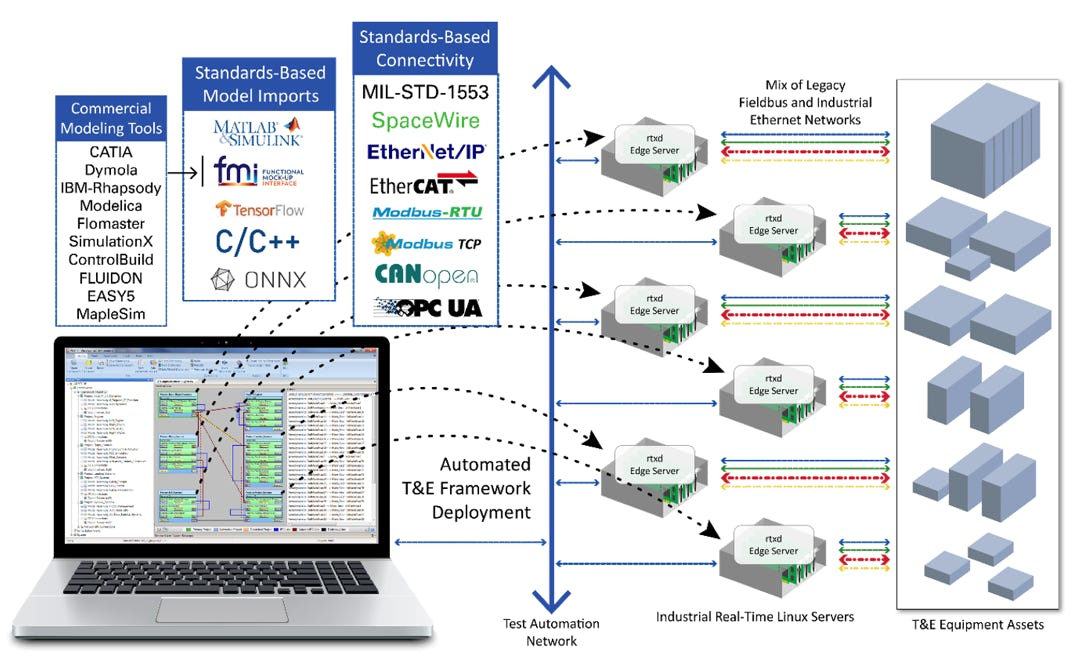ADEPT Overview
ADEPT is an industrial IoT software platform that helps you make the most of your digital assets. Whether your assets are simulations, control models, or production software, ADEPT offers drag-and-drop connectivity to physical I/O and one-click deployment of an entire framework with built-in runtime monitoring, control and data acquisition.
Data Framework
The ADEPT Framework was built around the concept of a “data framework” that links real-time Linux servers as a distributed resource and provides desktop client control of the time-deterministic computing and data handling capability. The ADEPT framework integrates any digital engineering asset, including simulation models, hardware-in-the-loop, software-in-the-loop and human-in-the-loop user interfaces. ADEPT uses a drag-and-drop interface to package digital engineering assets in model assemblies that communicate with each other through data-centric interfaces called data dictionaries or “DCTs”. Model assemblies can be local or distributed across a set of server resources and ADEPT determines which data needs to be communicated throughout the framework and when. By decoupling data communication from algorithm development, your team can focus on creating the best models while ADEPT handles everything that is not core to your value add.
ADEPT also uses time and frequency-based computation. Time- and frequency-based computation allows an entire framework of digital assets to run in lock-step as a single system. When the frequency of computation matches that of the real world, then your digital assets can be connected to the physical I/O and interact with other systems in real-time; however, when your models can run in a digital environment, then they have the potential to run faster (to get results quicker) or slower (if more computation is needed) than real-time.
Back to top

Time- and Frequency-Based Computation
ADEPT Data Framework Concept

Standards-Based Model Types and Connectivity
Models & Connectivity
ADEPT offers unparalleled standards-based computing and connectivity that can greatly reduce engineering effort for digital engineering and digital transformation projects of all sizes.
ADEPT allows drag-and-drop import of models written in all popular simulation tools and programming languages, which enables users to leverage existing model assets as well as allows engineers to develop new assets in the language that is best suited to their activity. Not only does ADEPT support these different model types, but it allows different model types to be used in the same framework with efficient, built-in data exchange through data dictionary interfaces. See our ever-growing list of supported model types for more details.
ADEPT also offers industry leading connectivity that enables your models to connect with the physical world in real-time. With standards-based connectivity support for most popular aerospace, vehicle and industrial communication protocols, as well as support for all types of direct I/O, ADEPT can support even the most demanding applications with hundreds of interfaces and thousands of signals. See our supported physical I/O for more details.
Back to top

Preferred Server Equipment
Servers & rtxd
ADEPT Frameworks are deployed to one or more rtx server(s) for real-time or virtual operation. Real-time operation allows the framework to interface with physical I/O connected to the rtx server. The physical I/O options available to an rtx server are almost limitless due to the open architecture and use of off-the-shelf computer hardware and interfaces. Virtual operation can be achieved for any framework that doesn’t require physical I/O and has the benefit of being able to run faster or slower than real-time, depending upon the amount of computation needed, and can be run in parallel on scalable cloud resources to dramatically speed up extensive test campaigns.
The key to making an rtx server is the rtxd, or “rtx daemon”, which is a set of Linux services that transform an ARM- or Intel-based computer into a full–featured real-time compute engine that is internally instrumented for performance and health monitoring, including latency, jitter, and other precision time-based measurements.
The rtxd software was developed, refined, and optimized by ADI over three decades. The goal of the rtxd is to simplify the development and management of time-deterministic programming. By installing rtxd on your real-time Linux servers you get, right out of the box, a set of optimized real-time services with a multi-processor, multi-server distributed real-time computing and data handling architecture within a scalable client-server paradigm. The rtxd dramatically reduces the engineering and IT costs of modernizing your computing and data handling assets.
Back to top
ADEPT-DE provides the development environment for rapidly assembling real-time cyber-physical applications and desktop interfaces. ADEPT-DE is an open environment that directly supports a variety of modeling tools, including Simulink, C/C++, Fortran and mixed-language models. GNU compilers and cross-compilers are integrated in the system and projects are built using the Make facility.

ADEPT Framework Client Tools Overview
